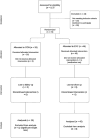A Novel Low-Impact Resistance Exercise Program Increases Strength and Balance in Females Irrespective of Menopause Status
- PMID: 39480197
- PMCID: PMC11801421
- DOI: 10.1249/MSS.0000000000003586
A Novel Low-Impact Resistance Exercise Program Increases Strength and Balance in Females Irrespective of Menopause Status
Abstract
Introduction: The reduction in sex hormone production across the menopause transition is thought to accelerate age-related decline in muscle mass, strength, and stability, increasing the risk of falls and fractures. We aimed to investigate whether a novel low-impact resistance exercise program could improve strength, balance, and body composition and whether any improvement was affected by menopause status.
Methods: Seventy healthy, moderately active pre- (PRE; 46.7 ± (SD) 3.2 yr), peri- (PERI; 52.3 ± 2.2 yr), or post- (POST; 57.0 ± 2.5 yr) menopausal females, not taking hormone replacement therapy (HRT), were randomized to continue habitual physical activity (CON; n = 25) or complete a supervised resistance exercise program 4 d·wk -1 for 12 wk (EXC; n = 45). Strength at the hip and shoulder (isokinetic dynamometer), dynamic balance (Y-balance), flexibility (sit-and-reach and back-scratch), muscle thickness (rectus femoris, vastus intermedius (VI), and medial deltoid), and lean and % body fat (dual-energy x-ray absorptiometry) were measured before and after training.
Results: Hip abduction and flexion peak torque (19% ± 48% and 20% ± 17%, respectively; P < 0.05), posterolateral and posteromedial balance (12% ± 15% and 13% ± 15%, respectively; P < 0.001), flexibility (21% ± 36%, P < 0.001), VI thickness (12% ± 19%, P = 0.032), and lean mass (2% ± 2%, P = 0.007) all increased over 12 wk in EXC, but not CON, with no difference in response between PRE, PERI, and POST. The changes in shoulder strength and body mass over 12 wk were not different between CON and EXC.
Conclusions: This is the first study to demonstrate that the decline in sex hormones and an increase in age across the menopause transition do not affect the ability of lower limb (hip) strength and balance to adapt to a low-impact resistance exercise training program in females not taking HRT.
Trial registration: ClinicalTrials.gov NCT05397418.
Copyright © 2024 The Author(s). Published by Wolters Kluwer Health, Inc. on behalf of the American College of Sports Medicine.
Figures





References
-
- Bondarev D Laakkonen EK Finni T, et al. . Physical performance in relation to menopause status and physical activity. Menopause. 2018;25(12):1432–41. - PubMed
-
- Kurina LM Gulati M Everson-Rose SA, et al. . The effect of menopause on grip and pinch strength: results from the Chicago, Illinois, site of the Study of Women's Health Across the Nation. Am J Epidemiol. 2004;160(5):484–91. - PubMed
-
- Janssen I, Heymsfield SB, Ross R. Low relative skeletal muscle mass (sarcopenia) in older persons is associated with functional impairment and physical disability. J Am Geriatr Soc. 2002;50(5):889–96. - PubMed
Publication types
MeSH terms
Associated data
LinkOut - more resources
Full Text Sources
Medical

